Mule tramcars and old trailers
CCAPFM
Little is know about the tram-cars of the CCAPFM. The closed cars, at least the first delivered, were of the type with the semi-circular ground glass windows above the main windows like trailer 8 has. The first two cars, which were delivered in September 1871, were of the type of trailer 9, now in Crich. In October 1871 an open car arrived with seven transverse benches. In March 1872, when services started there were probably six cars available. In May 1872 another six cars arrived. The “O Primeiro de Janeiro” of 3 June 1879 notified that after the fireworks of the Senhor de Matosinhos festivities the company did let ride a convoy of 30 mule tram-cars. When merging with the CCFP, the CCAPFM had a total of 31 tram cars, but it is unknown how many there were of the several different types.Top of page
CCFP until 1892
In 1874 the CCFP acquired from Starbuck 28 tram-cars for passengers:- 2 cars with imperial and seats for 20 inside
- 10 closed cars with seats for 20
- 12 closed cars with seats for 12
- 2 open cars with transverse seats
- 1 open car with longitudinal seats facing inside
- 1 open car with seats in the middle (probably knife-board arrangement)
In 1875 three more cars were acquired from Starbuck. In 1875/6 two open and two closed cars came from the Societé Metallurgique Charbonnièr Belges and in 1876 two other open cars from Leon et Eugene Deletrez (Paris). In October 1877 a car was presented in the Palácio de Crystal build by the workshops of the CCFP. By 1878 the number of cars was to 43. But the origins and types of the new cars are unknown. The cars 44 & 45 were new constructed in 1879. In 1882 the number of passenger cars was raised from 45 to 51 by acquiring and reconstruction of 6 cars of the Larmanjat system, which operated during a short period from Lisbon to Sintra and Torres Vedras. These got the numbers 46-51. In 1883 the workshops constructed car no.52. in 1885 two new cars were constructed, a closed car got the no.53 and the other new car the number 32, evidently replacing an older car as the size of the fleet was extended by only one car. For 1885 the annual report gives a specification of the different types of cars:
- 20 large closed cars
- 9 medium sized closed cars
- 13 small closed cars
- 1 large car with imperial
- 10 open cars
Top of page
CCFP since 1893
The merging of both companies must have resulted in renumbering, but no data were found about how this was done. Of seven cars it is known for which electric tram they were used. In 1901/2 the mule cars / trailers 59, 60, 62, 85, 55, 54 & 61 became the electric trams 18, 28, 29, 30, 31, 32 & 35. The electric cars 18, 30, 32 and 35, (mule cars / trailers 59, 85, 54 & 61) were of the 8-window original CCAPFM type. Electric tram 29 (62) was of the 7-window CCFP type. Of both other cars the type is unknown.In total 30 mule cars / trailers were converted into 26 closed and 3 open motorcars. In 1908 one was converted back. Most of the not into motorcars transformed mule cars were retained as trailers until the arrival of the bogie trailers and the closure of the steam tramline. In 1904 the trailers were renumbered into the 100-series. Before 1904 probably they still had the old numbers. In 1905 five trailers (136, 151, 153, 167 & 169) went out of service. In 1907 the remaining cars were renumbered into the series 1-59. The same year large trailer no.27 was scrapped and two years later also the 31 had disappeared leaving 57 cars in 1909:
- 5 closed trailers with seating for 20 on 2 benches: 1, 15, 16, 19 & 30
- 25 closed trailers with seating for 18 on 2 benches: 2-14, 17-18, 20-29
- 3 closed trailers with seating for 14 on 2 benches: 33, 36 & 37
- 6 closed trailers with seating for 12 on 2 benches: 32, 34-35, 38, 47 & 48
- 10 closed trailers with seating for 10 on 2 benches: 39-46, 49 & 50
- 2 open trailers with seating for 16 on 2 benches: 51-52
- 1 open trailer with seating for 18 on 2 benches: 53
- 1 open trailer with seating for 28 on 7 benches: 54
- 3 open trailers with seating for 24 on 6 benches: 55-57
- 2 open trailers with seating for 20 on 5 benches: 58-59
- 1 with seating for 20: 19
- 13 with seating for 18: 8-13, 16-18, 22, 25, 27 & 28
- 1 with seating for 14: 33
- 3 with seating for 12: 32, 38 & 47
- 6 with seating for 10: 40-44 & 46
Top of page
STCP
It seems that the STCP kept only three large (9, 10, 11) and two small (8, 13) trailers on the fleet. Four old electric cars were converted into the trailers 21-24. Around 1960-1966 they were all phased out. Trailer 8 was one of the first museum cars. Trailer 9 was sold to the Crich museum in the UK. Trailer 22 was electrified again to represent the oldest type of electric tram in the museum.Top of page
Photos
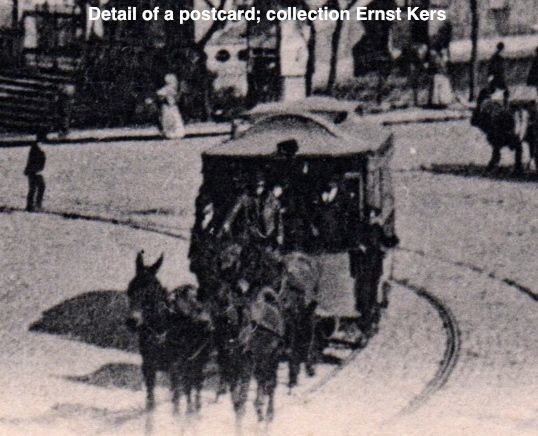
A mule tram at Batalha.
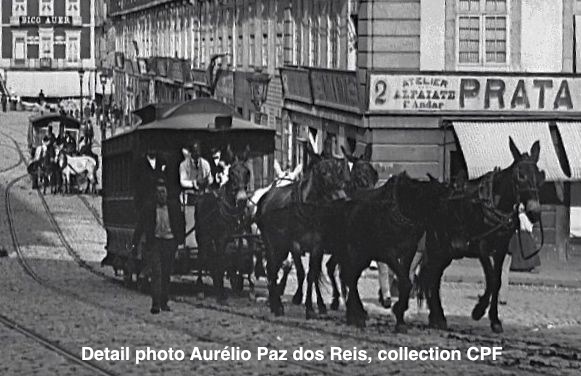
A mule tram of the 7-window type just departed from Praça. Six animals are necessary to get it up Rua dos Clerigos. I the background a second mule tram is prepared to follow. This is an open tram of the Risca-ão-meio type.
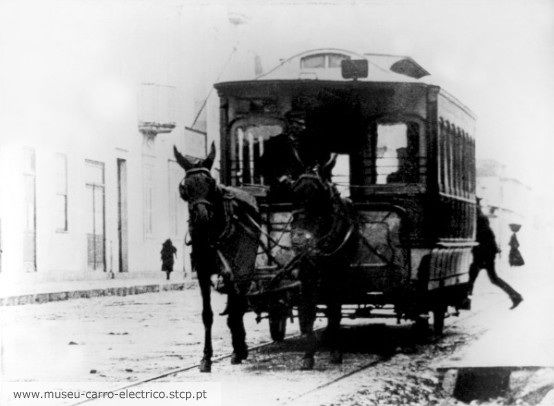
A closed mule tram.
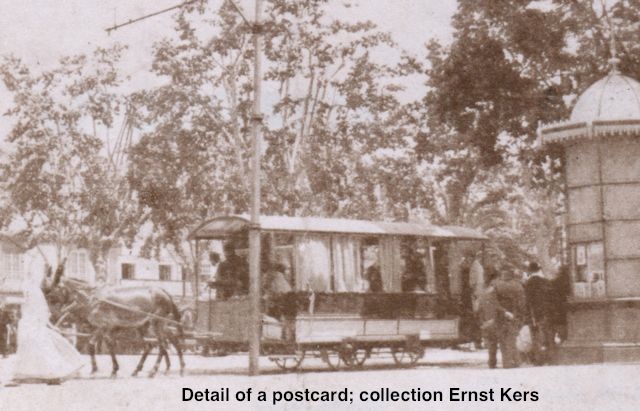
An open mule tram of the Risca-ão-meio type.
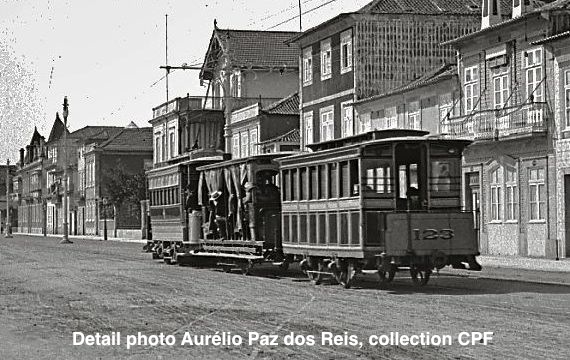
An electric tram with two trailers at Passeio Alegre. The last trailer is supposed to come from the Larmanjat system. In the centre an open trailer of the cross-bench type. The electric tram was once a mule tram, likely coming from the CCAPFM.
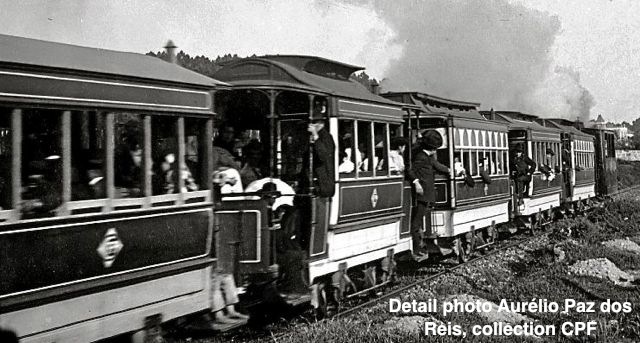
A steam tram with five trailers. In sequence from nearest to the camera to the Henschel locomotive: a medium sized trailer of the CCFP, a small trailer of the CCFP, a large trailer original of the CCAPFM, a large trailer of the CCFP and a large trailer original of the CCAPFM. Of the small trailer the platforms are enlarged like also was done with museum tram no.8. The third trailer likely had seats on the roof, but these had been removed.
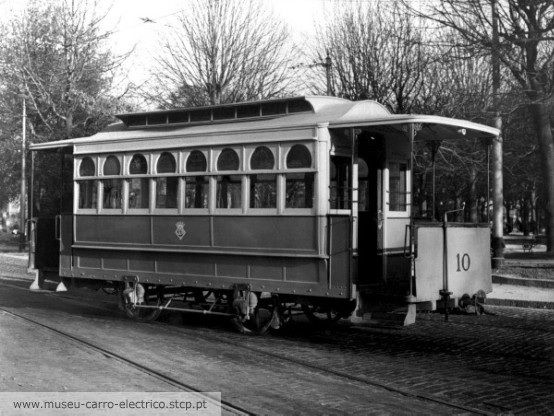
Trailer of the STCP, which likely started life about 1872 with the CCAPFM.
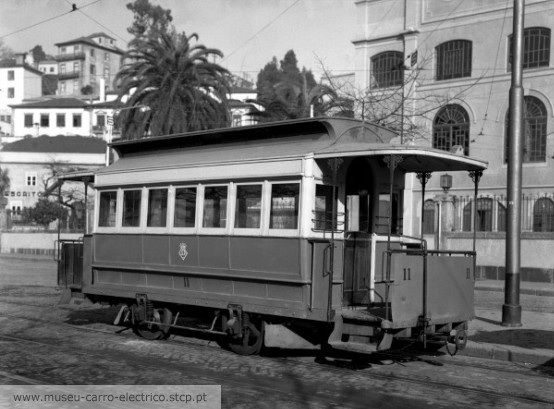
Trailer of the STCP, which likely started life with the CCFP.
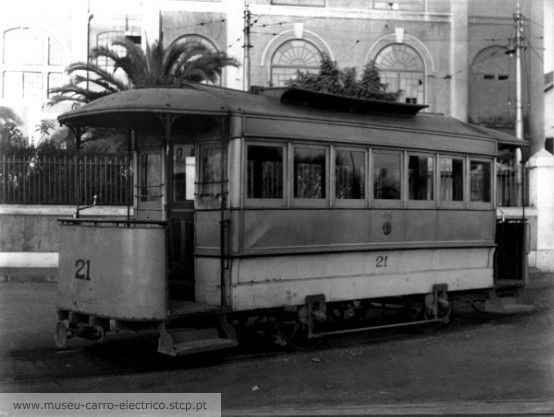
Trailer of the STCP, which likely started life with the CCFP. This car was converted to electric tram around 1895-1903 and into a trailer around 1946-1947.